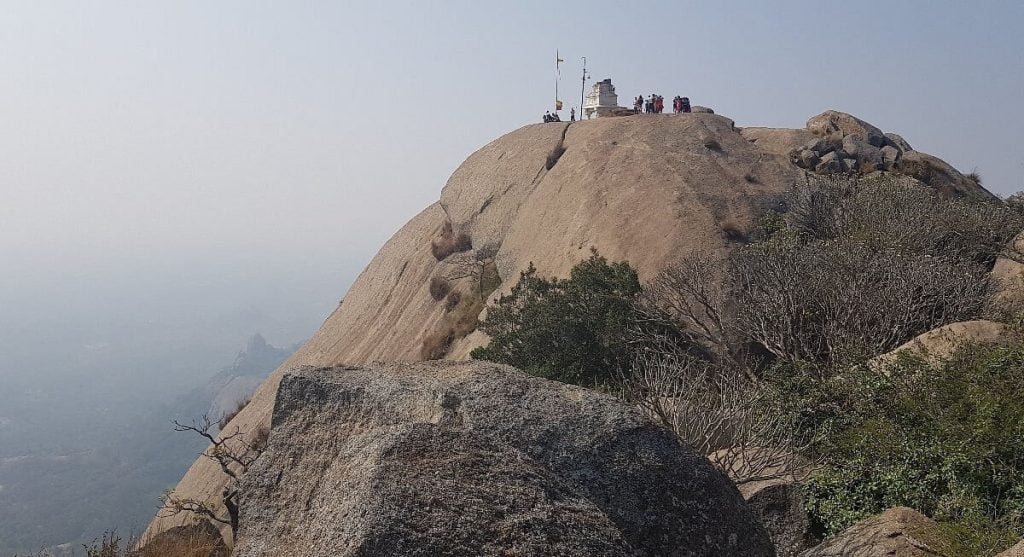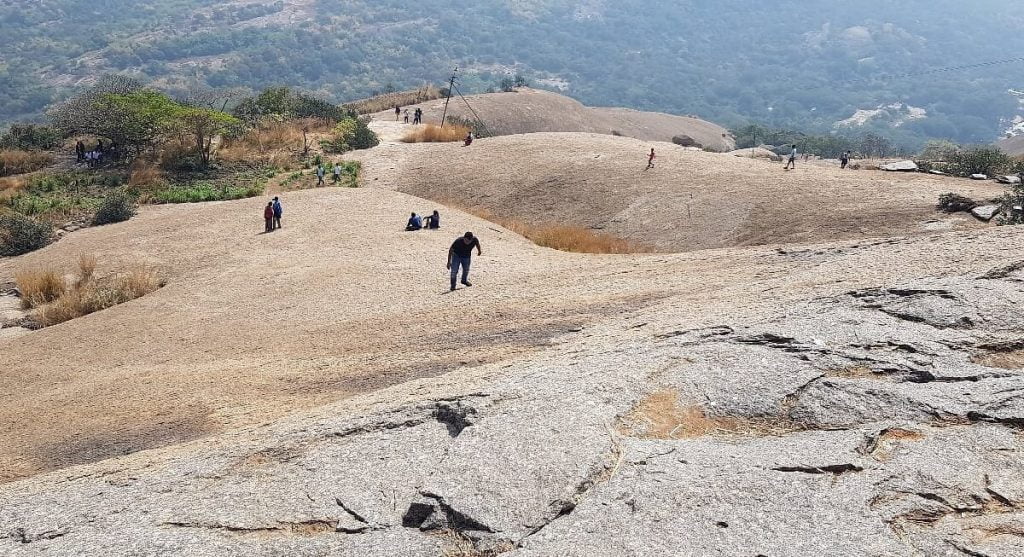Brief About Savandurga Trek
Savandurga Trek is a challenging climb to the top of Asia’s largest monolith hill located 60 km away from Bengaluru in the Savandurga state forest. Along the way, you’ll witness the breathtaking views of Magadi, Manchabele, Thippagondanahalli reservoirs, and Arkavathi river.
Savandurga is also known as the Fort of Death due to its steep incline and defense structure. The hill cluster consists of Karigudda (Black hill) and Biligudda (White hill) and has two temples at the base – Savandi Veerabhadraswamy temple and Sree Lakshmi Narasimhaswamy temple.
These temples date back to 1340 AD and attract devotees from various parts of Karnataka. The base of the temple is surrounded by a forest with thick bamboo groves and dense shrubs. You can explore the herbal plantation that has close to 60 species of trees used for local herbal medicines.
Key details of the Savandurga Trek:
- Ideal Number of Days for the Visit: 1 day
- Trek Distance: 3 km one way
- Trek Altitude Range: 4022 feet
- Starting Point: Magadi Village
- Nearest Railway Station: Bangalore City Railway Station (48 km)
- Nearest Airport: Kempegowda International Airport, Bengaluru (90 km)




Table of Contents
Best Places to Visit near Savandurga Trek
We found three nearby places worth exploring. The first is Dodda Alada Mara, a 400-year-old Banyan Tree with aerial prop roots that have matured into thick trunks, covering an area of 3 hectares.
The second is Manchanabele Dam, which supplies water to the town of Magadi and offers breathtaking views of the backwaters of the Arkavathi river. Visitors can enjoy activities like boating and kayaking on the beautiful lake formed by the dam.
Finally, Thippagondanahalli Reservoir, also known as Chamarajasagar, is a popular recreational spot frequented by nature and bird lovers. It’s an ideal place for bird watching, where you can spot various species of avian fauna.
What is the best time to visit Savandurga Trek
It is recommended to do the Savandurga Trek between the end of September to February, which is the best season for this trek. During summer, the rocks radiate a lot of heat, and during the monsoon, the trail becomes slippery and dangerous, making it difficult to climb.
Therefore, it is not recommended to do this trek during summer and peak monsoon months. Winter months are the best for this trek as the trail is open and does not feature any trees.
How to reach the starting point of the trek?
To reach Savandurga from Bangalore by vehicle, there are two routes to choose from. The first route is about 50 kilometers long and includes a visit to the 400-year-old Dodda Aladamara Banyan Tree. The second route is almost 63 kilometers long but offers scenic views of the rural and green side of Bangalore. It is recommended to take the second route for a more enjoyable experience.
For those using public transport, the most convenient way to reach Savandurga is by taking a bus from the Majestic Bus Stop to Magadi, and then a shared auto or bus to the Sri Lakshmi Narasimhaswamy Temple. Shared autos are available every 15 minutes and cost Rs. 20 per person, while buses are available every 30 minutes and cost Rs. 15 per person.
Availability of accommodations and food near the trek
Food:
Travellers planning to trek Savandurga should bring their own food since there are no restaurants or proper meal options available at the base or in the nearby village. Snack stalls are the only source of food, and non-purified groundwater is the only water source available. Therefore, it is recommended to bring at least 2 litres of water from home if you are allergic to groundwater.
Accommodation:
As it is a one-day trek, there is no need to stay near the base, and you can book a hotel in Bangalore or the nearby village and travel from there.
The Difficulty level of the Savandurga Trek
If you’re a first-time trekker, don’t worry, the Savandurga night trek is moderate and does not require any prior experience or professional training. However, you need to be careful during the rocky terrains, especially since it’s a night journey. While the trek is not classified as difficult, trekkers should always be prepared for any eventuality.
During monsoons, the trail can become extremely slippery, so it’s important to be careful with your choice of footwear and check weather charts to avoid days with anticipated heavy rain. There are also parts of the trek where trekkers will be required to scale small boulders or walk between large rocks. While descending, one can easily lose their grip and slip since the trail is primarily on steep granite rock, so it’s recommended to descend slowly one step at a time while keeping an eye on the trail.






